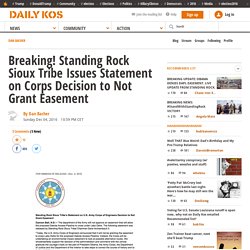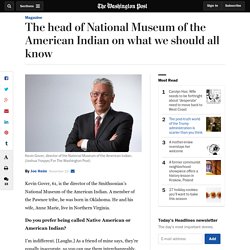

Sen. Reid Calls for Alternative Pipeline Route. Harry Reid Show Full Text Show Less Text.

Breaking! Standing Rock Sioux Tribe Issues Statement on Corps Decision to Not Grant Easement. The Standing Rock Sioux Tribe has just issued a statement on the U.S.

Army Corps of Engineers decision to not approve an easement that will allow the proposed Dakota Access Pipeline to cross under Lake Oahe. The news was reported on MSNBC and confirmed in the statement by the Tribe. Standing Rock protesters hit with water cannon – video. Recommended → Standing Rock Speaks, by Walter Kirn. Only as a story will this make sense.

One morning in August, craving company, I walked around the corner from my apartment in Livingston, Montana, and sat down at the counter of Pinky’s Cafe. The place was unusually empty for the summer, which is when Livingston fills with visitors from all over the world. I ordered pancakes and gazed out through the big picture window onto Main Street. There were almost no cars, and not a single pedestrian. The town was sleepy. I mentioned this to the café’s owner, who seemed surprised I hadn’t heard the news. Ten days later, in early September, the river had partially reopened, but the town was still deserted as I sat in my office reading Black Elk, by Joe Jackson, a comprehensive new biography of the fabled Sioux medicine man. Jackson’s new biography rattled me with its relentless bleakness. STANDING ROCK SIOUX TRIBE - Revolution Advisors Revolution Advisors. The Standing Rock Sioux Reservation is located in both North and South Dakota and covers 2.3 million acres of allotted and tribally-owned land.

The culture of the Lakota people is rich and the traditions, language and lifeways of their ancestors in some ways are still practiced today. As such, cultural preservation was a key component of their focus as was a strong need to increase economic activity to address pervasive poverty in the community. There was also a strong need for building consensus among the various communities on the reservation on a path forward and a strong need for disciplined implementation that could make the plan a reality. The Situation Revolution Advisors worked with the tribe to address a wide range of needs and goals. Standing Rock Protester in Danger of Losing Arm After Police Use Force. On 20 November 2016, the Dakota Access pipeline protests reached new proportions when an ongoing demonstration turned into a violent confrontation between protesters and law enforcement officials.

Pipeline protesters say 21-year-old Sophia Wilansky was critically injured when she was struck with a concussion grenade thrown by Morton County sheriff's deputies while she was handing out water. As a result, she has been hospitalized and now faces the prospect of having her left arm amputated. On 21 November 2016, Wilansky's father, Wayne Wilansky, released extremely graphic photographs of her badly damaged arm, showing exposed bone and muscle. (We will link to them here, but caution that they are disturbing.)
He told reporters that she may need as many as 20 surgeries, and that aside from her arm injury, Sophia had welts all over her body from being shot by rubber bullets, and that it took hours for an ambulance to reach her because of roadblocks: Suicide in Native American Communities A Transactional-Ecological Formulation of the Problem. Senator Elizabeth Warren's Statement on Standing Rock. By Elizabeth Warren I don’t know how anyone could watch the news and not be horrified by what’s happening at Standing Rock Reservation in North Dakota.

For months, the Standing Rock Sioux and thousands of others have opposed a pipeline that many believe risks contaminating the tribe’s water supply. What have they faced in response? Attack dogs. Rubber bullets.
Army will not grant easement for Dakota Access Pipeline crossing. By U.S.

ArmyDecember 4, 2016 Army POC: Moira Kelley (703) 614-3992, moira.l.kelley.civ@mail.mil The Department of the Army will not approve an easement that would allow the proposed Dakota Access Pipeline to cross under Lake Oahe in North Dakota, the Army's Assistant Secretary for Civil Works announced today. Head of Natl Museum of the American Indian on what we should all know. Kevin Gover, 61, is the director of the Smithsonian’s National Museum of the American Indian.
"Take Standing Rock, for example. If you knew nothing about the history of the Sioux Nation, the United States, the Missouri River itself, you might well conclude, Well, look, everybody has to have a pipeline at some point, so why should they be any different? And that would be a perfectly rational point of view." "But if you know what the history of the Sioux Nation is, you know that treaties were made with the Sioux Nation concerning these lands that no longer belong to the Sioux Nation. And you know that the development of the Missouri River for the past century has always, always involved taking of Indian land. They were building dams up and down the Missouri, and every Indian reservation along the way was flooded. Some of the best land was flooded, which only deepened their poverty and made it that much harder to climb out. So we should know that kind of history. We need to know that in order to know what equity is in this contemporary situation." – sassylpt
A member of the Pawnee tribe, he was born in Oklahoma.

He and his wife, Anne Marie, live in Northern Virginia. Do you prefer being called Native American or American Indian? I’m indifferent. [Laughs.] What is accurate? What each tribal nation calls itself, whatever they choose to call themselves, then that’s what they are first and foremost. There’s so much that most Americans don’t know about Native American history. Just a basic civics lesson: That Indian tribes are governments. Is there a question that Native Americans get tired of being asked? I think native people actually welcome questions and are very responsive.